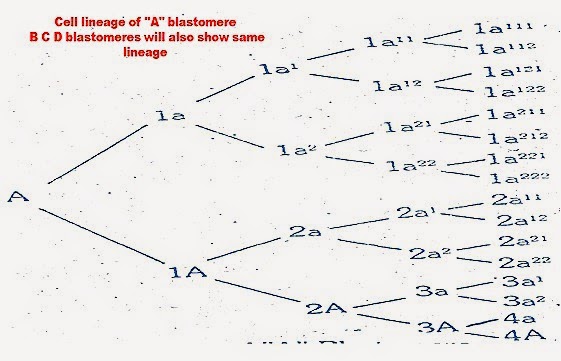PLANOCERA-DEVELOPMENT
Planocera belongs to
Phylum:Platyhelminthes,
class Turbellaria and
order Polycladida.
The development of this organism- is completely studied. Its zygote will undergo spiral clevage.
1. Clevage is complete. The first two divisions are meridional and are at right angles to each other. Four cells are formed, out of the four cells, posterior cell is biggest and the remaining three are small.
2. In order to notice their fate these are named with alphabets.
3. These four Cells are called with A, B, C and D names.
4. 'D' cell is the biggest.
5. Third cleavage is horizontal. 8 cells are formed. Out of 8 cells 4 are micromeres and 4 cells are macromeres. la, lb, lc and Id will form 1st quartet.
6. This 8 celled stage will undergo another cleavage and 16 celled stage is resulted.
7. This 16 celled stage will undergo another division and 32 celled stage is formed.
8. At this stage 3A, 3B, 3C, 3DMacro
meres and 1, 2 and 3 quartets of micromeres are present. The cells of first three quarters will give epidermis. This embryonic stage is called Gastrula.
9. Again a cleavage is carried on 4a, 4b, 4c and 4d cells are formed. This is called 4th quartet.
10. 4A, 4B, 4C, 4D, 4a, 4b and 4c cells will disintegrate and form food for the developing embryo.
11. 4d cell is big. It is called Mesoblast cell. It will divide and give 4d', 4d2 cells. 4d> will divide and give 4d" 4d12 will give endoderm of the intestine.

12. 4d21, 4d22 cells will give endoderm of the pharynx and also mesoderm. This mesoderm will give muscles, mesenchyme and reproductive systems.
Fate of different cells - 1
|
S.No |
Cells |
Fate |
|
1. |
1a * 1d Series |
Dorsal epidermis, Brain, Frontal organ |
|
2. |
2a - 2d Series |
Outer epidermis, Muscles of Pharynx |
|
3. |
3a - 3d Series |
Outer epidermis, some |
|
Muscles of the body |
||
|
4. |
4a, 4b, 4c, & |
Disintegrate and form food |
|
4A, 4B, 4C, 4D |
to the embryo |
|
|
5. |
4d' |
Endoderm of Intestine |
|
6. |
4d' |
Endoderm of pharynx and Mesoderm |
Then the gastrula transforms into Müllers larva.
Muller's larva:
1. This larva is oval in shape. It freely swims in the sea water.
2. On its ventral side mouth is present
3. On this larva ciliated band is present. This ciliated band is useful for swimming.
4. At the apex a bunch of cilia will be present. This bunch is called apical tuft.
5. Below the apical tuft of cilia two eye spots are present.
This larva will swim for 4 or 5 days in the water. Then it will transform into adult.
